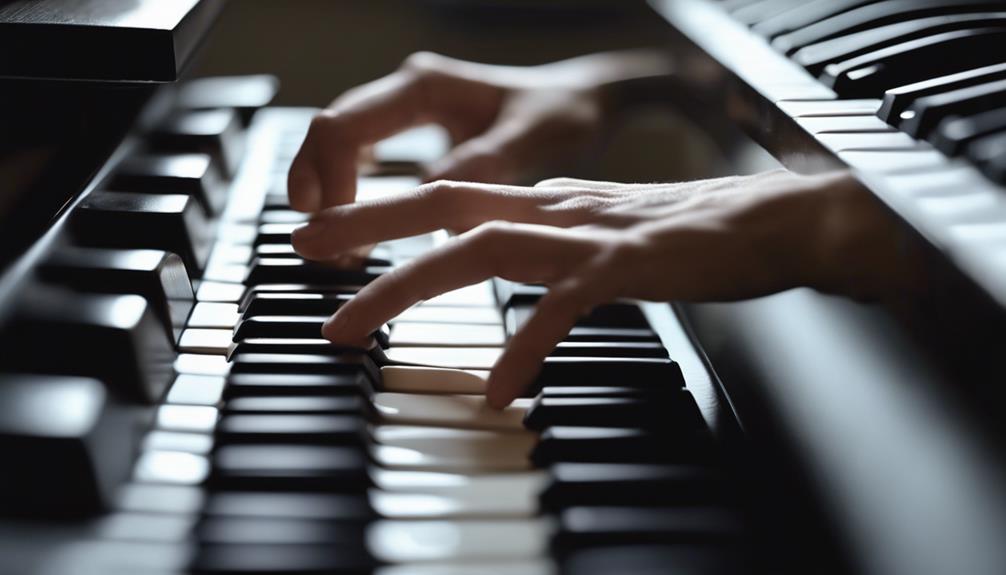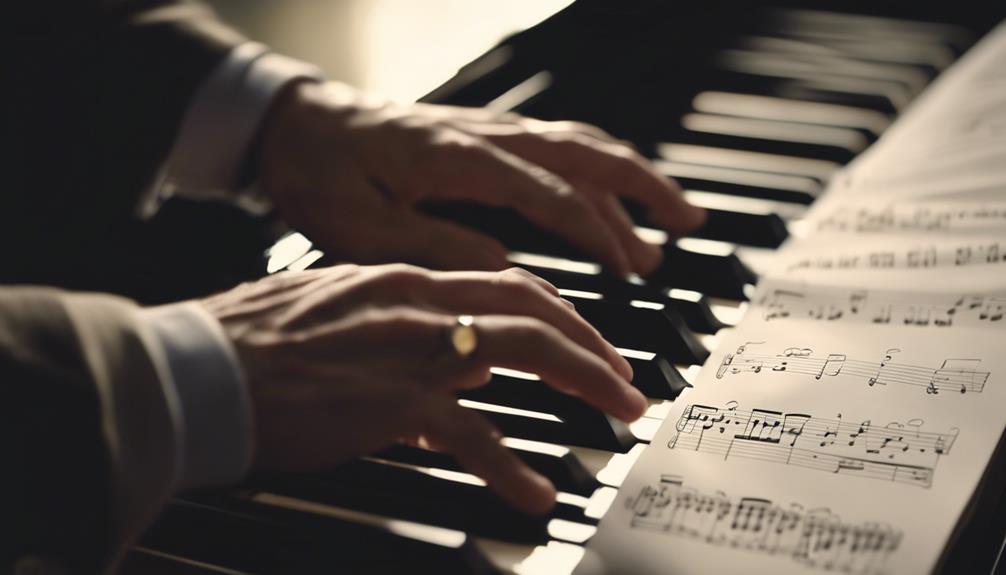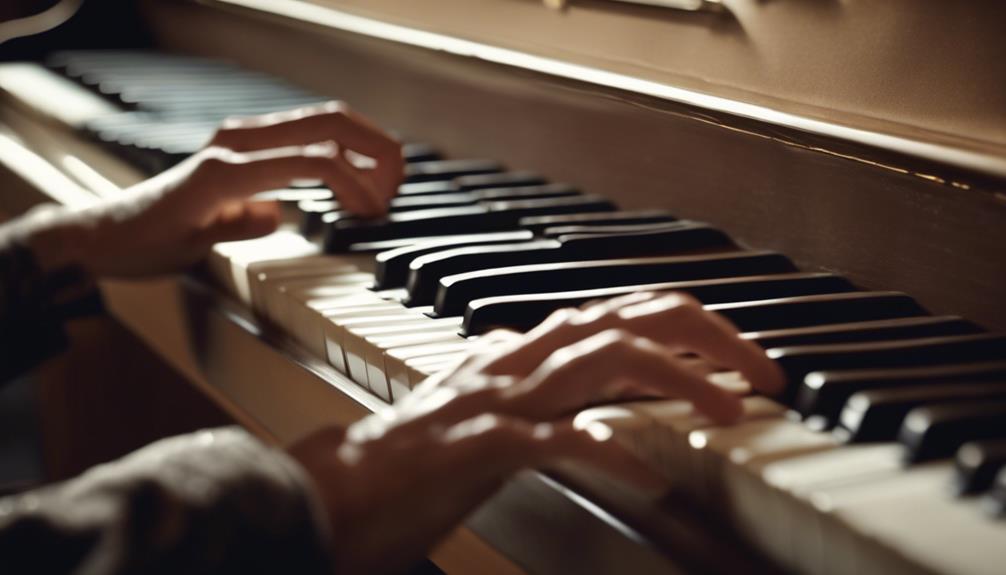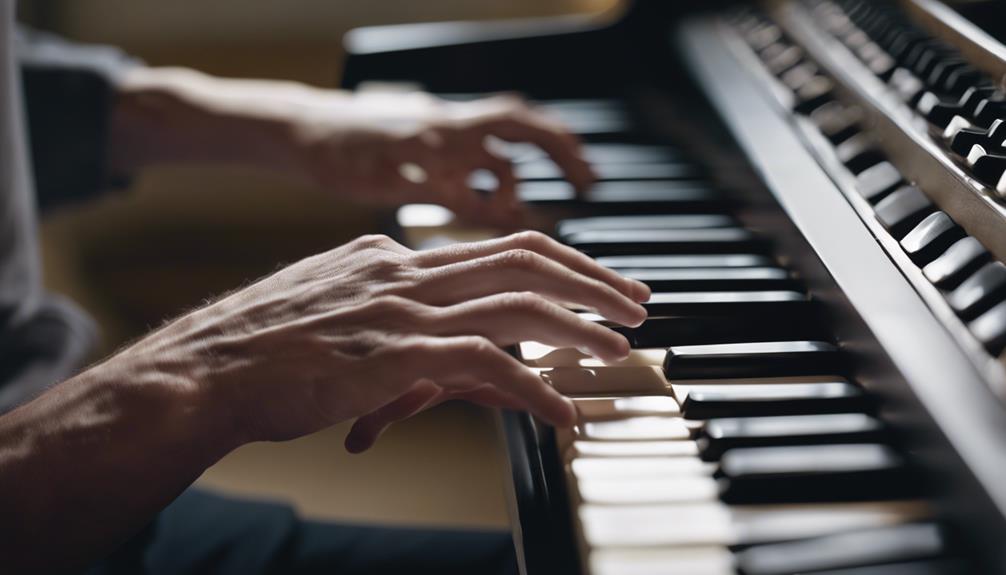Improving finger independence for piano playing is essential for mastering complex pieces and achieving fluidity in your performance. You might think it’s all about practicing scales, but there’s more to it. You need to incorporate specific exercises that target finger control and dexterity, like the Five-Finger Exercise and Hanon Exercise. These routines can make a significant difference in your technique. Additionally, dedicating time to arpeggio drills and strength exercises will further enhance your finger flexibility and control. But before diving into these exercises, it’s important to understand why finger independence matters and how you can systematically improve it.
TL-DR
- Practice specific exercises like Five-Finger and Hanon to strengthen finger control and dexterity.
- Incorporate exercises with trills and holding down certain notes to improve finger coordination.
- Regularly perform finger stretching exercises to increase flexibility and prevent hand fatigue.
- Gradually increase exercise complexity to ensure steady progress in finger independence.
- Aim for focused daily practice sessions of 20-30 minutes, setting specific goals for each session.
Understanding Finger Independence

To master piano playing, you need to understand what finger independence is and why it’s vital. Finger independence refers to your ability to move each finger separately when playing the piano. This skill is essential for tackling complex pieces and executing different rhythms at the same time. Without finger independence, your fingers might move together awkwardly, making it difficult to play intricate passages smoothly.
To develop this skill, you should incorporate specific exercises into your practice routine. These exercises focus on strengthening finger control and dexterity. One effective technique is to hold down certain notes while playing scales with the remaining fingers. This helps improve coordination and ensures that each finger can move independently without relying on its neighbors.
Another useful exercise involves playing trills, where you rapidly alternate between two notes. This activity forces your fingers to work independently and can greatly boost your agility over time.
Benefits of Finger Independence
When you improve your finger independence, you enhance your overall playing techniques and gain better control over your musical expression.
You’ll find that your fingers move more fluidly and accurately, allowing you to tackle complex pieces with confidence.
This increased dexterity not only boosts your performance but also enables you to convey emotion and nuance in your music more effectively.
Enhanced Playing Techniques
Mastering finger independence transforms your piano playing by allowing each finger to operate with precision and speed. When your fingers move independently, you gain superior finger control, which is essential for executing intricate playing techniques. This enhanced control enables you to manage hand independence more effectively, letting each hand perform different rhythms or melodies simultaneously.
Improving finger independence boosts your coordination and dexterity, essential for tackling complex compositions. As you practice, muscle memory develops, allowing your fingers to glide effortlessly across the keys, making even the most challenging pieces feel more manageable. You’ll notice a substantial improvement in your ability to play complex passages quickly and accurately.
Exercises like the Finger Independence Challenge are excellent for strengthening each finger individually. By dedicating time to these exercises, your overall playing technique will see significant improvement. You’ll feel more confident when approaching difficult sections of music, knowing your fingers can handle the demands placed on them.
Ultimately, better finger independence not only enhances your technical skills but also showcases your proficiency and dedication to the instrument. With stronger finger control, you’ll find yourself capable of achieving new heights in your piano playing journey.
Increased Musical Expression
Building on the enhanced playing techniques, finger independence greatly boosts your musical expression by allowing for more nuanced and dynamic performances. When your fingers can move independently, you can play different rhythms and melodies simultaneously, adding layers of complexity and depth to your music. This skill showcases your proficiency, making it easier to tackle complex pieces with confidence.
With better finger independence, your coordination improves, leading to a stronger connection between your brain and hands. This enhanced coordination allows you to execute difficult passages more fluidly and expressively, conveying the emotions and intentions behind each note.
Strengthening your finger independence also promotes better muscle coordination and dexterity. This not only leads to more dynamic performances but also boosts your confidence when tackling challenging compositions. As you develop this skill, you’ll find that your musical expression becomes richer and more compelling, enthralling your audience every time you play.
- Nuanced dynamics: Control over each finger lets you vary the volume and intensity of individual notes, adding emotional depth.
- Complex rhythms: Play intricate rhythms seamlessly, enhancing the overall texture of your performance.
- Expressive melodies: Execute expressive lines with greater precision, bringing out the character of each piece.
Warm-Up Techniques

Start your warm-up routine with finger stretching exercises to prepare your hands for practice.
Pay attention to proper hand positioning to avoid strain and maximize efficiency.
Incorporate simple finger drills that progressively challenge your coordination and dexterity.
Finger Stretching Exercises
Incorporating finger stretching exercises into your warm-up routine can dramatically enhance your finger flexibility and dexterity for piano playing. These exercises are essential for improving finger independence and preventing hand fatigue. By regularly practicing them, you’ll find your fingers moving more freely and comfortably across the keys.
Here are a few key benefits of finger stretching exercises:
- Increase flexibility: Stretching helps you achieve a greater range of motion, allowing for smoother changes and more fluid playing.
- Prevent hand fatigue: Proper stretches reduce muscle tension, which can minimize the risk of strain and injury.
- Enhance finger independence: By working each finger individually, you improve control and coordination, leading to better overall performance.
To get started, try simple stretches like spreading your fingers wide apart and holding the position for a few seconds. Another effective exercise is to place your hand flat on a surface and gently lift each finger one at a time. These exercises don’t take long but can make a significant difference in your playing.
Hand Positioning Tips
Ensuring proper hand positioning before you begin playing the piano can greatly enhance your technique and prevent injuries. Start with a relaxed hand position, keeping your wrists level with the keyboard. This helps you maintain control and fluid motion. Essential hand positioning is vital for developing finger independence, as it sets the foundation for all your movements.
Begin your warm-up with finger stretches and flexibility exercises. Stretch each finger individually, then gently spread and close your fingers. These stretches prepare your hands for the intricate movements required for piano playing. Focus on maintaining proper finger curvature and alignment on the keys. Your fingers should be slightly curved, not flat, with the pads of your fingers pressing the keys.
Use slow, deliberate movements to ensure accuracy and control. This practice helps you become more aware of your hand positioning, reducing the risk of strain or injury. Incorporate hand exercises like finger taps and rolling motions to improve finger dexterity. Finger taps involve tapping each finger on a flat surface, while rolling motions mimic the act of playing scales.
These exercises not only warm up your hands but also enhance finger independence, making your playing more fluid and precise.
Simple Finger Drills
After establishing proper hand positioning, let’s explore some simple finger drills to enhance your finger independence and control. These warm-up exercises are designed to improve dexterity, coordination, and agility, vital for effective piano playing.
Start with the ‘Five-Finger Exercise.’ Place your hand on the keyboard so that each finger rests on adjacent white keys. Play each key from your thumb to your pinky and back again. Repeat this pattern slowly at first, then gradually increase speed. This drill focuses on smooth, fluid motion, helping each finger work independently.
Next, try the ‘Hanon Exercise.’ These classic drills involve repetitive sequences that target specific finger movements. They not only warm up your fingers but also build muscle memory and strength. Start with the first exercise from Hanon’s ‘The Virtuoso Pianist,’ and repeat it several times.
Finally, practice the ‘Trill Exercise.’ Place two fingers on adjacent keys and alternate rapidly between them. This exercise is excellent for improving finger independence and agility, as it forces quick, precise movements.
Incorporating these simple drills into your daily practice ensures smoother, more precise piano performance.
- Five-Finger Exercise: Focus on smooth, fluid motion.
- Hanon Exercise: Build muscle memory and strength.
- Trill Exercise: Improve finger agility and precision.
Basic Finger Exercises
Mastering basic finger exercises is crucial for enhancing your finger independence and control on the piano. Start by focusing on exercises that isolate each finger, one hand at a time. For example, try holding down a simple chord with one hand while playing individual notes with the other. This will challenge your brain and fingers to work independently, fostering greater control and coordination.
One effective exercise involves playing five-finger patterns, where each finger plays a consecutive note in a scale-like manner. Keep your hand relaxed and make sure each finger presses the key with equal pressure. This simple drill greatly improves finger dexterity and independence.
Another valuable exercise is the ‘Hanon’ series, which consists of repetitive finger patterns designed specifically to strengthen your fingers. These exercises might seem tedious, but practicing them regularly will significantly enhance your finger agility and control.
Scale Practice

Scale practice is essential for building finger independence and improving overall piano technique. By focusing on a five-finger scale, you can enhance your dexterity and control. Start with a simple scale from C to G and back, using only your thumb to pinky. This basic exercise lays the groundwork for more complex movements.
To make scale practice even more effective, try holding down different notes while playing the scale. This technique, known as the Finger Independence Challenge, helps strengthen your fingers and improves coordination. Here’s how you can incorporate this into your routine:
- Hold down the C note with your thumb while playing the rest of the five-finger scale.
- Next, hold down the D note with your index finger and continue the scale.
- Progress through each finger, holding down a different note each time and playing the rest of the scale.
This method challenges you to maintain finger position and control, boosting muscle memory.
As you become more comfortable, try skipping over the held notes while playing the scale up and down. This added complexity will further enhance your finger independence, preparing you for more advanced piano pieces.
Arpeggio Drills
When practicing arpeggio drills, focus on finger strength exercises to build the necessary power in each finger.
Additionally, work on smooth shift techniques to guarantee fluid movement between notes.
These strategies will enhance both your finger independence and overall piano performance.
Finger Strength Exercises
Arpeggio drills, which focus on playing broken chords in a specific sequence, are essential for building finger strength and independence. These exercises are a cornerstone in finger independence exercises and can greatly improve coordination and agility. By practicing arpeggio drills regularly, you’ll notice a marked enhancement in your overall piano technique.
When you start with arpeggio drills, consider these tips to make the most of your practice:
- Vary the speed: Begin slowly to guarantee accuracy and gradually increase the tempo to challenge your fingers.
- Change dynamics: Practice playing softly and loudly to develop control over each finger.
- Use different keys: Don’t stick to just one key. Playing arpeggios in various keys will further enhance your finger independence and adaptability.
Adding these variations to your practice routine can make a significant difference.
By focusing on these finger independence exercises, you’ll build the strength and dexterity needed for more complex pieces.
Smooth Transition Techniques
Mastering smooth shift techniques in arpeggio drills is crucial for achieving a fluid and polished piano performance. Arpeggio drills focus on playing broken chords smoothly, which is imperative for developing finger independence. By practicing these drills, you play each note of a chord individually in a flowing manner, strengthening your fingers and improving coordination between your hands.
To enhance finger flexibility and control, practice arpeggio drills in different keys. This variation challenges your fingers to adapt to different positions on the keyboard, thereby improving your overall dexterity. Implementing these exercises regularly builds muscle memory, making your shifts between notes smooth and effortless.
When working on seamless progression techniques, pay close attention to the evenness and clarity of each note. Start slowly to guarantee accuracy, gradually increasing your speed as you become more comfortable. Focus on maintaining a consistent tone and dynamic level throughout the arpeggio.
Incorporate arpeggio drills into your daily practice routine to see significant improvements in your playing. Not only will these exercises refine your finger independence, but they’ll also contribute to a more cohesive and expressive performance. Remember, consistency and patience are key to mastering these techniques.
Chord Inversions

Chord inversions, which rearrange the notes of a chord, add variety and richness to your music by changing its sound and color. By practicing chord inversions, you’ll not only enhance the harmonic texture of your pieces but also improve finger independence and hand coordination. When you shift from one inversion to another, each finger must adapt to new positions, fostering better control and dexterity.
To get started with chord inversions:
- Practice the root position, first inversion, and second inversion of common chords.
- Focus on smooth shifts between inversions to minimize hand movement.
- Experiment with different chords and inversions to understand their unique sounds.
Rhythm Variations
Delve into rhythm variations in your piano practice can greatly enhance your musical expressiveness and creativity. By changing the timing and emphasis of notes within a piece, you can breathe new life into familiar compositions. This approach not only makes your playing more dynamic but also serves as a fantastic independence exercise.
When you apply different rhythms to each hand independently, you directly improve hand coordination. For example, try playing a steady quarter-note rhythm with your left hand while your right hand tackles a syncopated rhythm. This challenges your brain to manage separate timing patterns simultaneously, which is essential for improving finger independence.
Experimenting with various rhythm patterns also requires you to think critically about timing and phrasing. Start with simple patterns like alternating between staccato and legato, then gradually introduce more complex rhythms such as triplets or dotted notes. This will help you develop a keen sense of timing and add depth to your musicality.
Mastering rhythm variations won’t just improve your technical skills; it will also make your performances more engaging. So, immerse yourself in these exercises and watch as your hand coordination and finger independence reach new heights.
Hands-Independent Playing

When practicing hands-independent playing, focus on separate hand coordination to guarantee each hand can move fluidly and precisely on its own.
You’ll need to work on asynchronous hand movements, which involve playing different rhythms or melodies simultaneously.
With consistent practice, you’ll notice significant improvements in your musical expression and overall performance.
Separate Hand Coordination
By practicing each hand independently, you’ll develop the finger independence needed to tackle complex piano pieces with ease. Separate hand coordination is essential for mastering piano playing. It allows each hand to handle different rhythms, melodies, or notes simultaneously, greatly boosting your overall proficiency.
To enhance hand independence, start by focusing on simple exercises. Play scales or arpeggios with one hand while the other remains still. This helps train each hand to work autonomously and improves finger independence. Gradually increase the complexity of the exercises as you become more comfortable.
Here are some practical tips to get started:
- Practice scales separately: Play scales with your right hand first, then switch to your left hand. This ensures each hand gets equal attention.
- Use metronome: Set a slow tempo and practice each hand individually to guarantee precision and coordination.
- Incorporate different rhythms: Play a steady rhythm with one hand and a syncopated or varied rhythm with the other to challenge your coordination.
Asynchronous Hand Movements
Building on separate hand coordination, mastering asynchronous hand movements enables you to play different rhythms or melodies with each hand independently, creating more complex and dynamic pieces. This technique is important for enhancing hand independence and overall coordination. By focusing on asynchronous movements, you’ll find that your ability to play intricate pieces improves greatly.
Start by practicing simple exercises that require one hand to play a steady rhythm while the other plays a varied melody. This will challenge your brain-hand coordination and help you get accustomed to the independence of each hand.
Playing by ear can also be a valuable tool in this process, as it encourages you to listen carefully and respond to what each hand is doing without relying solely on sheet music.
As you become more comfortable, gradually increase the complexity of the pieces you practice. Look for compositions specifically designed to improve hands-independent playing. These pieces will push your fine motor skills further and enhance your musicality.
Strengthening Weak Fingers
Strengthening weak fingers can dramatically enhance your piano performance by improving dexterity and control. To achieve finger independence, you need to focus on strengthening exercises that specifically target your weaker fingers. These exercises won’t only improve your finger strength but also enhance your overall hand coordination.
Here’s how you can get started:
- Scales: Practicing scales with a metronome guarantees that each finger gets its turn, helping you identify and work on your weaker fingers.
- Arpeggios: These exercises require you to use all your fingers in succession, promoting even strength and flexibility.
- Finger independence drills: Isolate individual fingers and practice tapping them independently while keeping the other fingers still. This builds control and agility.
Regular practice is essential. Set aside dedicated time each day to focus on these exercises. Don’t rush; patience is key to building strength in weak fingers.
As you continue to practice, you’ll notice significant improvements in your ability to play more complex pieces with ease and precision.
Gradual Complexity

To guarantee finger independence, you’ll need to gradually increase the complexity of your exercises. Start by holding down specific notes while playing scales or arpeggios. This technique forces your fingers to work independently, strengthening control and dexterity over time.
Initially, hold down one note with a finger while the others play a simple scale. As you get comfortable, add more notes to hold down or shift to different key signatures.
This gradual complexity challenges your fingers to adapt to various conditions, building muscle memory effectively. The more you practice, the more your fingers will learn to move independently without conscious effort.
Consistently incorporating exercises of increasing complexity into your routine ensures steady progress.
Don’t rush the process—let each stage become second nature before moving on to the next. This method not only improves finger independence but also sharpens your overall piano technique. Your fingers will become more agile, responsive, and capable of tackling more intricate pieces.
Common Mistakes
One common mistake is lifting your fingers off the keys instead of holding them down while playing. This habit can greatly hinder your progress in finger independence. When you’re struggling with holding specific fingers down, it disrupts the flow and control you need for more complex pieces.
Many pianists face challenges with the sequential holding of different notes, which is essential for achieving smooth changes and maintaining rhythm.
Here are some common mistakes you might encounter:
- Lifting fingers prematurely: This breaks the continuity of the sound and reduces finger strength.
- Neglecting finger position: Not focusing on maintaining proper finger positioning hampers your ability to control each finger independently.
- Skipping practice on weaker fingers: Avoiding exercises that target your weaker fingers leads to imbalanced finger strength and agility.
Addressing these mistakes begins with awareness and adjustment. For instance, consciously remind yourself to keep your fingers on the keys during practice. Pay close attention to how each finger interacts with the keys, especially when performing sequential holding of different notes. This will improve your finger independence and overall playing technique.
Consistent Practice

Committing to consistent daily practice is vital for mastering finger independence on the piano. Aim for focused sessions of 20-30 minutes each day, as these short yet intense intervals can greatly enhance your finger strength and control.
During these sessions, repetition is your best ally. Regularly practicing finger independence exercises, such as scales and arpeggios, will gradually build the necessary dexterity and precision.
Set specific goals for each practice session to track your progress. For instance, focus on playing a particular scale smoothly or improving the tempo of an arpeggio. This targeted approach ensures you’re not just practicing but practicing effectively.
It’s also important to be mindful during these sessions—concentrate on the movement of each finger and aim for evenness and clarity in your playing.
Consistency in your practice routine will lead to noticeable gains. Over time, you’ll find that your fingers move more independently and with greater ease. By sticking to a daily regimen, you’re setting yourself up for steady improvement and ultimately, more expressive and controlled piano playing.
Patience and Perseverance
Mastering finger independence on the piano requires patience and perseverance, as progress often comes slowly but steadily. You’ll find that developing the control and agility needed for complex pieces doesn’t happen overnight. Instead, it’s a gradual process where consistent effort pays off over time.
To keep yourself motivated, remember to:
- Celebrate small victories. Each new level of control and coordination is a step forward.
- Embrace the process. Understand that struggles and challenges are natural parts of learning.
- Set realistic goals. Break down your practice into manageable tasks to avoid frustration.
Patience is essential when working on finger independence exercises. You mightn’t see immediate results, but each practice session builds a foundation. Perseverance is equally important. Even when progress seems slow, sticking with your practice routine will lead to improvement.
Think of finger independence as a muscle that needs regular exercise. Just like physical fitness, the more you work at it, the stronger and more agile your fingers will become. Over time, you’ll notice enhanced playing skills and greater confidence in your abilities. Keep pushing forward, and remember that every bit of effort contributes to mastering the piano.
Embracing the Challenge

Embracing the challenge of finger independence means actively engaging with exercises that push your limits and foster greater control over your playing. For piano players, this involves holding down specific notes while playing a scale, which enhances coordination and control. As you progress, you’ll hold different notes sequentially, requiring intense focus to prevent your fingers from lifting off the keys.
The journey isn’t easy, but it’s crucial for any pianist aiming to master finger independence exercises. Consistent practice and persistence are your best allies. Overcoming these struggles will lead to enhanced autonomy and efficiency in your playing. You’ll find that your fingers move more fluidly and independently, allowing you to tackle complex pieces with greater ease.
Personalizing these exercises can make a significant difference. Apply the patterns you’ve learned to chord progressions, and you’ll notice an improvement in hand independence and overall musical growth. This tailored approach ensures that you’re not just going through the motions but truly engaging with the exercises in a meaningful way.
Next up, learn how to teach yourself piano in this guide.
